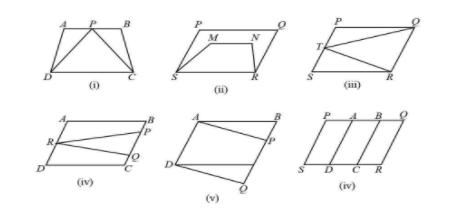
Which of the following figures lie on the same base and between the same parallels. In such a case, write the common base and the two parallels.


Answer
574.8k+ views
Hint: In the solution we will use the concept of same base and same parallels which states that when two figures have a similar side which is base and lines are parallel opposite to common base.
Complete step-by-step solution
In figure (i), the $\Delta PDC$ and trapezium $ABCD$ both are lying on the similar base $DC$ and among the same parallel lines which are $DC$ and $AB$.
Therefore, both the figures lie on the same base and between the same parallels line.
In figure (ii), the trapezium $SMNR$ and parallelogram $PQRS$ both are lying on the same base $SR$ but not between the same parallel lines.
Therefore, both the figures lie on the same base but not between the same parallels line.
In figure (iii), the $\Delta RTQ$ and parallelogram $PQRS$ both are lying on the same base $QR$ and between the same parallel lines $QR$ and $PS$.
Therefore, both the figures lie on the same base and between the same parallels line.
In figure (iv), the $\Delta PQR$ and parallelogram $ABCD$ both are not lying on the same base but between the same parallel lines $BC$ and $AD$.
Therefore, both the figures are not lying on the same base.
In figure (v), the trapezium $APCD$ and quadrilateral $ABQD$ both are lying on the same base $AD$ and between the same parallel lines $AD$ and $BQ$.
Therefore, both the figures lie on the same base and between the same parallels line.
In figure (vi), the parallelogram $ABCD$ and parallelogram $PQRS$ both are not lying on the same base $SR$ and don’t lie among the same parallel lines.
Therefore, both figures don’t lie on the same base.
Note:In such types of questions, make sure to use the same base and same parallel concept in any geometric figures i.e “when two figures have a similar side which is base and lines are parallel opposite to common base”.
Complete step-by-step solution
In figure (i), the $\Delta PDC$ and trapezium $ABCD$ both are lying on the similar base $DC$ and among the same parallel lines which are $DC$ and $AB$.
Therefore, both the figures lie on the same base and between the same parallels line.
In figure (ii), the trapezium $SMNR$ and parallelogram $PQRS$ both are lying on the same base $SR$ but not between the same parallel lines.
Therefore, both the figures lie on the same base but not between the same parallels line.
In figure (iii), the $\Delta RTQ$ and parallelogram $PQRS$ both are lying on the same base $QR$ and between the same parallel lines $QR$ and $PS$.
Therefore, both the figures lie on the same base and between the same parallels line.
In figure (iv), the $\Delta PQR$ and parallelogram $ABCD$ both are not lying on the same base but between the same parallel lines $BC$ and $AD$.
Therefore, both the figures are not lying on the same base.
In figure (v), the trapezium $APCD$ and quadrilateral $ABQD$ both are lying on the same base $AD$ and between the same parallel lines $AD$ and $BQ$.
Therefore, both the figures lie on the same base and between the same parallels line.
In figure (vi), the parallelogram $ABCD$ and parallelogram $PQRS$ both are not lying on the same base $SR$ and don’t lie among the same parallel lines.
Therefore, both figures don’t lie on the same base.
Note:In such types of questions, make sure to use the same base and same parallel concept in any geometric figures i.e “when two figures have a similar side which is base and lines are parallel opposite to common base”.
Recently Updated Pages
Basicity of sulphurous acid and sulphuric acid are

Master Class 9 General Knowledge: Engaging Questions & Answers for Success

Master Class 9 English: Engaging Questions & Answers for Success

Master Class 9 Science: Engaging Questions & Answers for Success

Class 9 Question and Answer - Your Ultimate Solutions Guide

Master Class 12 Business Studies: Engaging Questions & Answers for Success

Trending doubts
What is meant by exothermic and endothermic reactions class 11 chemistry CBSE

Which animal has three hearts class 11 biology CBSE

10 examples of friction in our daily life

One Metric ton is equal to kg A 10000 B 1000 C 100 class 11 physics CBSE

1 Quintal is equal to a 110 kg b 10 kg c 100kg d 1000 class 11 physics CBSE

Difference Between Prokaryotic Cells and Eukaryotic Cells




